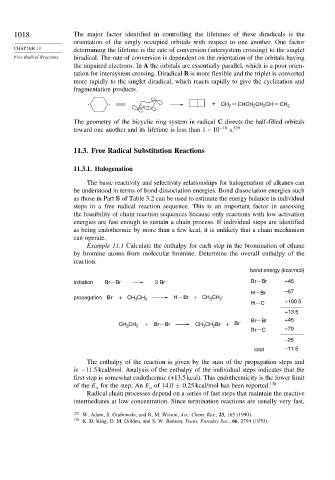Page 1034 - Advanced Organic Chemistry Part A - Structure and Mechanisms, 5th ed (2007) - Carey _ Sundberg
P. 1034
1018 The major factor identified in controlling the lifetimes of these diradicals is the
orientation of the singly occupied orbitals with respect to one another. One factor
CHAPTER 11 determining the lifetime is the rate of conversion (intersystem crossing) to the singlet
Free Radical Reactions biradical. The rate of conversion is dependent on the orientation of the orbitals having
the unpaired electrons. In A the orbitals are essentially parallel, which is a poor orien-
tation for intersystem crossing. Diradical B is more flexible and the triplet is converted
more rapidly to the singlet diradical, which reacts rapidly to give the cyclization and
fragmentation products.
+ CH 2 CHCH CH CH CH 2
2
2
The geometry of the bicyclic ring system in radical C directs the half-filled orbitals
toward one another and its lifetime is less than 1×10 −10 s. 129
11.3. Free Radical Substitution Reactions
11.3.1. Halogenation
The basic reactivity and selectivity relationships for halogenation of alkanes can
be understood in terms of bond dissociation energies. Bond dissociation energies such
as those in Part B of Table 3.2 can be used to estimate the energy balance in individual
steps in a free radical reaction sequence. This is an important factor in assessing
the feasibility of chain reaction sequences because only reactions with low activation
energies are fast enough to sustain a chain process. If individual steps are identified
as being endothermic by more than a few kcal, it is unlikely that a chain mechanism
can operate.
Example 11.1 Calculate the enthalpy for each step in the bromination of ethane
by bromine atoms from molecular bromine. Determine the overall enthalpy of the
reaction.
bond energy (kcal/mol)
initiation Br Br 2 Br . Br Br +45
H Br –87
.
propagation Br . + CH CH 3 H Br + CH 3 CH 2
3
H C +100.5
+13.5
CH CH 2 . + Br Br CH CH Br + Br . Br Br +45
3
3
2
Br C –70
–25
total –11.5
The enthalpy of the reaction is given by the sum of the propagation steps and
is −11.5 kcal/mol. Analysis of the enthalpy of the individual steps indicates that the
first step is somewhat endothermic (+13.5 kcal). This endothermicity is the lower limit
of the E for the step. An E of 14.0 ± 0.25 kcal/mol has been reported. 130
a a
Radical chain processes depend on a series of fast steps that maintain the reactive
intermediates at low concentration. Since termination reactions are usually very fast,
129 W. Adam, S. Grabowski, and R. M. Wilson, Acc. Chem. Res., 23, 165 (1990).
130
K. D. King, D. M. Golden, and S. W. Benson, Trans. Faraday Soc., 66, 2794 (1970).

